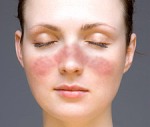![]() Inflammatory rheumatic diseases predominantly affect women. This also includes many young women who would like to have children or who have not yet completed their family planning when they are first diagnosed. These women do not need to give up on their desire to have children forever. Women with rheumatic disease tend to have fewer children than other women, and it often takes them longer to achieve a desired pregnancy. Today, carefully monitored medical treatment and close collaboration between the rheumatologist and the gynaecologist give these women the opportunity to bring a healthy child into the world.
Inflammatory rheumatic diseases predominantly affect women. This also includes many young women who would like to have children or who have not yet completed their family planning when they are first diagnosed. These women do not need to give up on their desire to have children forever. Women with rheumatic disease tend to have fewer children than other women, and it often takes them longer to achieve a desired pregnancy. Today, carefully monitored medical treatment and close collaboration between the rheumatologist and the gynaecologist give these women the opportunity to bring a healthy child into the world.
Tag: anti-SS-A
Portrait of the HEp2 cell, the pet of immunofluorescence professionals
HEp2 cells are held dear in autoimmune diagnostics. They are invaluable for people engaged in analysing autoantibodies, as E. coli is for molecular biologists or mice for toxicologists.
In spite of a wide range of other suitable methods and technologies, determination of autoantibodies with indirect immuno-fluorescence assays (IFA) on human epithelioma (HEp2) cells still contributes significantly to the diagnosis of autoimmune diseases. The widely recognised advantages of this method are high sensitivity and a broad spectrum of antibodies that can be analysed simultaneously. In addition to mere detection of antibodies a characteristic fluorescence pattern and staining of metaphase and cytoplasmic cells offer supplementary information.
When an autoimmune disease is suspected, the HEp-2 test usually is the first line test. Any positive result is then followed up by a step-wise diagnostic approach, including other immunological tests like ELISA (enzyme-linked immunosorbent assay) for single antibody specificities or immunoblot tests.
(more…)
Research Update: New Classification Criteria for Sjoegren’s Syndrome
Since the early 1960s almost a dozen different criteria for Sjögren’s syndrome (SS) have been published, both for classifying and for diagnosing that autoimmune disease. Recently, an international team of rheumatologists has published new classification criteria for Sjögren’s syndrome. In the April issue of the Arthritis Care & Research journal the authors propose clear and carefully worded guidelines.
Without question, these “new 2012 classification criteria for Sjögren’s syndrome” are urgently needed to better support etiologic and genetic research and therapeutic trials for Sjögren’s syndrome. Indeed, the new criteria are the first to be based solely on objective clinical tests!
Many other criterions have permitted various testing subjectivity to enable the classification of the disorder. In consequence, subjectivity has made standardisation of clinical trial inclusion something of a moving target, limiting comparability of research data across studies and impeding the needed robust clinical evaluation of possible new treatments. But criteria used for enrollment into clinical trials need to be clear, be easy to apply. And the new 2012 criteria agree to that demand. (more…)
Autoantibodies precede manifestation of Lupus by years
Antibodies to various autoantigens may be present in sera of patients who will develop Lupus erythematosus up to seven years before onset of disease symptoms
Autoantibodies are specific and sensitive biomarkers for autoimmune diseases and indispensible diagnostic tools. They may also be involved in pathogenic processes underlying the disease and will potentially occur in sera of apparently healthy people long before onset of the first symptoms.
C. Eriksson, S. Raantapaa-Dalquist and their colleagues from Umeå University in Sweden have focused on this preclinical phase in the development of Systemic Lupus Erythematosus (SLE). (more…)
Blood Tests for the Diagnosis of Lupus
Blood Tests for the Diagnosis of Lupus
Welcome to our Autoimmunity Blog! The subject of this post is blood tests for the diagnosis of lupus.
The emphasis of this article is on the detection of autoantibodies relevant to the diagnosis of SLE. Specifically, this includes detection of ANA (antinuclear antibodies) by immunofluorescence and individual tests for various ANA, including anti-dsDNA, anti-Sm, anti-U1RNP (also anti-U1-RNP or anti-RNP), and anti-histone, as well as anti-SS-A/Ro and anti-SS-B/La.
Tests for ANA are also highly useful in differential diagnostics, especially when diseases with symptoms resembling SLE must be distinguished from lupus itself, for example fibromyalgia, infections like tuberculosis and HIV/AIDS, or certain malignant tumours, particularly lymphoma and leukaemia. (more…)




